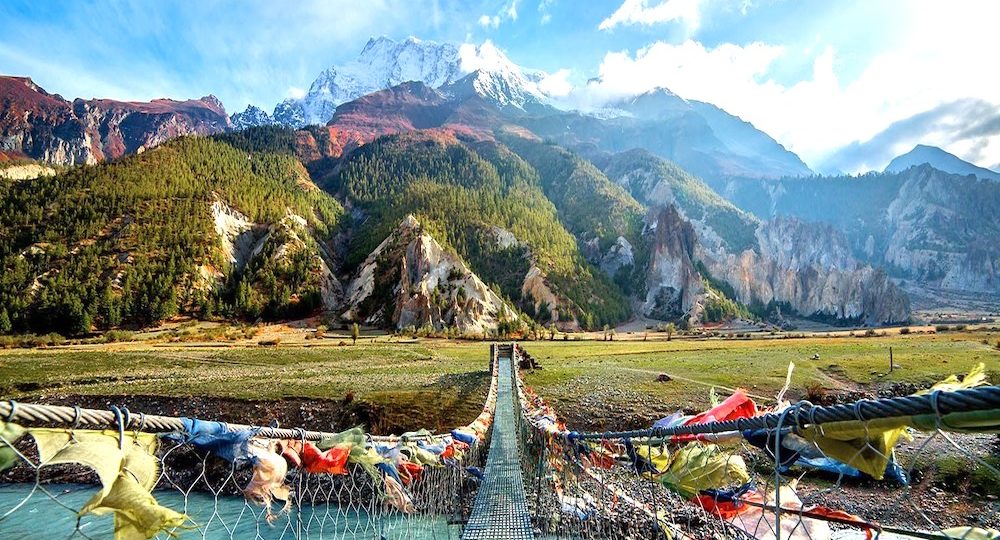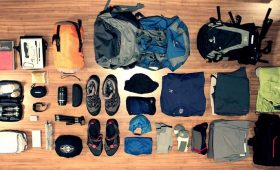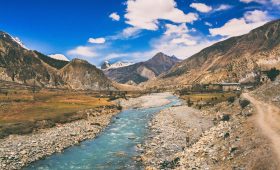Since the Annapurna Circuit trek opened to travelers in 1949. This is still among the most captivating trails in the country. More than 40,000 trekkers travel to the Annapurna region each year.
The Himalayas, home to the planet’s highest peaks including Mount Everest and some of the remotest, and most rugged and tough trekking terrains in the world. This huge range of mountains covers 3 quarters of Nepal, creating it one of the best destinations for trekkers.
Numerous treks crisscross the Himalayas, however arguably the foremost popular routes are the Annapurna Circuit trek and the Mount Everest Base Camp trek both of that reach up to altitudes of over 5,000m and take an average of two weeks to complete.
16 peaks over 6,000m. Annapurna is a section of the Himalayas in north-central Nepal known for its splendid panoramas, rugged scenery and isolated mountain communities even if we will hardly reach the mid-section of Annapurna.
We’ll be weaving our trail through the rice paddies and pastures of the foothills, visiting isolated mountain communities and observing completely different ancestral customs and traditions — this guarantees to not only be a visually superb expedition but also a culturally made one.
Facts of Annapurna Circuit Trek
- Group Size: 2 – 14 People
- Trip Grade: Moderate to Demanding
- Max. Altitude (5,416m) Thorong-la pass
- Walking Duration: 4 – 6 hours
- Trip Starts: Kathmandu
- Trip Ends: Kathmandu
- Accommodation: Hotels, guesthouses
- Trip Type: Teahouses
- Trip Destinations: Kathmandu, Shange, Dharapani, Chame, Pisang, Manang Yak Kharka, Thorong Phedi, Muktinath, Jomsom, Pokhara
Outline Itinerary of 12-Day Annapurna Circuit Trek
- Day 1: Arrive in Kathmandu (1400m)
- Day 2: Drive to Jagat (1300m) Approx. 8 hrs.
- Day 3: Trek to Dharapani (1,960m), Approx. 6 hrs.
- Day 4: Trek to Chame (2,710m) Approx. 5 hrs.
- Day 5: Trek to Pisang (3,300m), Approx. 5 hrs.
- Day 6: Trek to Manang (3540m), Approx. 6 hrs.
- Day 7: Acclimatization day at Manang (3540m)
- Day 8: Trek to Letdar (4230m), Approx. 4 hrs.
- Day 9: Trek to Thorong Phedi (4,600m), Approx. 4 hrs.
- Day 10: Trek to Muktinath (3,800m) via Thorong La pass (5416m), Approx. 8 – 9 hrs.
- Day 11: Trek to Jomsom (2,670m), Approx. 4 hrs.
- Day 12: Drive to Kathmandu (900m) Approx. 10 – 12 hours
Detailed Itinerary of 12-Day Annapurna Circuit Trek
Day 1: Arrive in Kathmandu (1400m)
Your journey begins when you arrive in Kathmandu. Our representatives will welcome you at the airport and transferred to the hotel. Depending on your own will, you can rest or discover the Kathmandu. In the evening a briefing session and at the same time introduces your guide.
Day 2: Drive to Jagat (1300m)
Drive duration: 7 – 8 hours
After breakfast, you will set off from Kathmandu to Jagat for a drive. Driving along the winding road through villages along the Trishuli River, you will enjoy the lovely view of hills and forests.
You will pass the popular village of Besisahar and further ahead until Jagat, your night destination.
Day 3: Trek to Dharapani (1,960m)
Walking Duration: 5 – 6 hours.
This is the day our trek begins. After breakfast, you take a downhill path through lush green forests. On this day you pass villages such as Chyamje, Sattale, Tal and Karte.
Suspension bridges and route carved in the rocky cliffs add an exciting aspect to the walk. On the first day of the journey the mountains come to sight Overall it is an easy walk. You stop at Dharapani for the night.
Day 4: Trek to Chame (2,710m)
Walking Duration: 5 hours.
On this day, on your way to Chame, you’ll trek through some forest ridges. The trail is mostly flat and easy.
You’ll be accompanied by a view of peaks like Lamjung Himal, Annapurna II and Annapurna IV. You’ll come across a hot spring on your way.
Your overnight night destination is Chame. Chame is district headquarters of Manang. You will see shops where you can prepare for the trek in the last minute. It’s also an administrative centre. At Chame overnight
Day 5: Trek to Pisang (3,300m)
Walking Duration: 4 – 5 hours.
This is the day when trek landscapes drastically change. You continue by walking along the Marsyangdi River in the dense forests.
The forest becomes thinner as you continue trekking. After crossing the altitude mark of 3,000 meters, the landscapes turns into a trans-Himalayan desert, with only a few alpine shrubs.
You can either go trekking via Upper Pisang or Lower Pisang. The Upper Pisang trail is comparatively steeper but the scenery is surreal. Lower Pisang way is easier. Choose one that best fits you. At Pisang overnight.
Day 6: Trek to Manang (3540m)
Walking Duration: 5 – 6 hours.
You can trek through the old village of Ngawal to Manang from Lower or Upper Pisang. Peaks like Annapurna, Gangapurna, and Tilicho are visible nearly all along the route. Unique rock formations with a thin forest of pine trees make up a magnificent scenery.
You will meet a monastery in Braga which is 400 years old. For the locals this monastery has historic symbolic importance. The architecture is amazing itself. You continue further ahead till you reach the beautiful Manang village. At Manang overnight.
Day 7: Acclimatization day at Manang (3540m)
Manang is without doubt one of the best acclimatization places. It offers spectacular views over the peaks of Annapurna and Gangapurna. Gangapurna Lake is another gem that is only a 10-minute walk from the village.
Visiting nearby monasteries gives you a glimpse of local culture and tradition. You have the option to go on side trips like Ice Lake and Milerapa Cave, perfect in Manang for a day-hike. No matter what you do, do not sleep in the daytime. That’s not good for acclimatization.
Here the hotels provide basic services and the untouched natural scenery in the backdrop makes Manang a great acclimatizing spot. At Manang Overnight
Day 8: Trek to Yak Kharka / Ledar (4230m)
Walking Duration: 4 hours.
This day’s trek is mostly through the rocky landscape, with just a few pastures and juniper shrubs. The route continuously ascends and descends across Jharsang Khola streams.
You also cross the wooden and suspension bridges along the way, passing through villages such as Tenki and Ghunasa. At Yak Kharka / Ledar overnight.
Day 9: Trek to Thorong Phedi (4,600m)
Walking Duration: 4 hours.
The Thorong Phedi trek is an uphill ascent. Giant rock formations give the landscape an incredible looks. Snow-capped Rocky mountains mixed with different-color textured drylands make for beautiful scenery.
Specific parts are landslide prone. Be careful walking along those trails. You’ll see one of the best views of Mt. Gundang, Mt. Syagang, Thorong Peak and Mt. Khatungkan upon reaching Thorong Phedi. Stop for day at Thorong Phedi and enjoy a night.
Day 10: Trek to Muktinath (3,800m) via Thorong La pass (5416m),
Walking Duration: 8 – 9 hours.
This is the most challenging and exciting day of the trek. You begin your preparation for the final ascent of Thorong La Pass at around 3 in the night. It gets windy during the day so the right choice is to start the ascend early in the morning. It’s a steep 3-4 hour climb until you reach the breathtaking Thorong La Pass vantage point.
From this point the sunrise is something that you’ll remember for a lifetime. Thorong La is two hours of steep climb b Since after midday it gets windy, we start our trek at around 3 am. Walking on an uphill trail for 2 hours, we reach 4900 m to the High Camp.
A few more hours from here will finally take us to the stunning Thorong La Pass vantage point.
From this point, sunrise experience is a once-in – a-lifetime experience. Seeing the first sun’s rays hit the Annapurna and Gangapurna is a dreamlike, surreal experience. Reaching Thorong La Pass gives you a sense of success and happiness. Prayer flags and mani-stones mark Thorong La Pass highest point.
After enjoying the view, you descend straight down to the Temple of Muktinath, an important Hindus pilgrimage site. The temple also holds utmost importance among the community of Buddhists.
You finish your trek, by driving to Jomsom and spending the night in a comfortable guesthouse.
Day 11: Trek to Jomsom (2,670m)
Walking Duration: 4 hours.
After Muktinath you head down to the Kaligandaki valley for a steep descent. From here you walk on to Jomsom. The trail is an easy one.
Jomsom is Mustang’s headquarter. Exploring the valley, you move to the picturesque Marpha village Well-decorated homes, narrow streets and the apple wine are what makes Marpha popular. At Jomsom overnight.
Day 12: Drive to Kathmandu via Pokhara (1400m)
Drive Duration: 10 – 12 hours.
Even if you plan to fly, you may end up needing to go by road if flights are canceled. The road between Beni and Muktinath was only constructed a few years ago, and it’s mostly off-road track, and (halfway) from Beni to Pokhara is paved. The journey takes about 6 to 7 hours, and then another 6 from Pokhara to Kathmandu.
It might takes longer if there are accidents or landslides en route during monsoon season. We Himalaya Discovery suggest you to change Hiace bus from Pokhara to Kathmandu for more comfortable ride.
Today you can either stay back and enjoy a free day in Kathmandu or leave for your respective countries. Our representatives will drop you off at the airport according to your flight schedule.
Best Time to Trek Annapurna Circuit Trek
The best time to trek the Annapurna Circuit is between March and May, and from September to December. From March to May, the Annapurna Circuit routes are covered with colorful blooming rhododendrons, and a variety of beautiful bird species can be spotted.
March through May and September to November are the best time to do the Annapurna Circuit Trek.
Annapurna Circuit Map – New Route
Annapurna Circuit Trek 12 Days – Requirements and Permits
A permit (ACAP: Annapurna Conservation Area Project) and Trekkers’ Information Management System (TIMS) card are required to enter the Annapurna area and trek to Annapurna Circuit. If you’re on a guided trip, the guide company will take care of getting the permit and TIMS card for you.
You can get your TIMS card on your own at offices of the Nepal Tourism Board in Kathmandu or at the national park entrance that you will pass through during your trek. Bring a high-quality photocopy of your passport and 2 passport photos.
Preventing Altitude Sickness
It’s important for anyone planning on attempting the Annapurna Circuit trek, or other high-altitude treks like Everest Base Camp, to know how to reduce and cope with the symptoms of altitude sickness. Before you go, learn the best ways to beat altitude sickness and stay healthy overall at high elevation.
- Climb slowly, give yourself time to acclimate to the elevation.
- Avoid alcohol
- Take rest days.
- Symptoms: headaches, sleeplessness, and nausea usually decrease in a day or two.
- Drink plenty of water and avoid alcohol.
- Eat a lot. Trekking burns a lot of calories.
- Keep your pace slow.
- If your symptoms fail to improve or worsen, descend.
Accommodations and Facilities
Tea houses are a great option and are an industry gaining rapid popularity right now. These are houses that are facilitated according to the local culture. This is a popular option and are designed to make you feel right at home with the hint of the local culture. What a great way to experience comfort.
Accommodations Tips during the Annapurna Circuit Trek
- Choose a guesthouse before 3 p.m. to beat large guided groups to the nicest guesthouses.
- Choose a smaller one for better meal service.
- Take a shower immediately after arriving because most hot water is solar power heated).
- Order breakfast before going to bed to speed your morning departure.
How Much Does the Annapurna Circuit Trek Cost?
The Annapurna Circuit trek cost range per person from USD 800 up to USD 1200 for an average 10 – 14 day trek.
Cost Includes: Transportations from and to Kathmandu, trek permits, accommodations, meals, but costs do not include: insurance, visa, personal equipment, drinks.
The advantage of booking a package trip to the Annapurna Circuit is that everything is taken care of for you. Accommodation will be booked, meals will be paid for and arranged. You should get to meet your guide before the trip.
Getting There
The Annapurna Circuit starts at Besisahar but the trek starts from Jagat. If you are planning to take a public bus, then you can catch a bus at Gonggabu bus park. (busses are big tourist type to slightly more comfortable “micro” busses).
Final Say
Annapurna Circuit Trek 12 days is considered to be one of the best treks in the world. Experiencing some of the most beautiful Himalayan mountain scenery of Nepal. And if you have questions or anything in mind please contact us.
Do you have any question about trip to Nepal?
Tell us about your trip to Nepal and what you expect from it. We will answer your questions in 24 hours and help you design a trip with a comfortable itinerary to best meet your needs.





